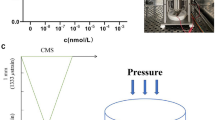Abstract
Introduction and hypothesis
The purpose of this study was to compare the success rate and urodynamic characteristics of the rat model of stress Urinary incontinence established by ovariectomy at different times after vaginal dilation.
Methods
Eighty female rats were randomly divided into three groups: the control group (n = 20), model group A (n = 30), i.e., the animals received colpectasis and bilateral oophorectomy within 1 day; model group B (n = 30), i.e., the animals received bilateral oophorectomy 1 week after colpectasis. The sneeze test and urodynamics were tested.
Results
There was no significant difference between the model group A and the model group B (p > 0.05) in the sneeze test. The leak point pressure (LPP) of model groups A and B was lower than that of the control group (p < 0.05). The LPP value of model group A was lower than that of model group B (p < 0.05). There was no significant difference in maximum bladder capacity (MBC) between model group A and the control group (p > 0.05); the MBC value of model group B was lower than that of the control group and model group A (p < 0.05).
Conclusions
Models of stress urinary incontinence in rats can be successfully established by both modeling methods. In terms of LPP, model groups A and B had lower values than the control group, and model group A had lower values than model group B. In terms of MBC, there was no difference between model group A and the control group, and model group B had lower values than the control group and model group A.

Similar content being viewed by others
References
Neveus T, von Gontard A, Hoebeke P, et al. The standardization of terminology of lower urinary tract function in children and adolescents: report from the Standardisation Committee of the International Children’s Continence Society. J Urol. 2006;176(1):314–24.
Aly WW, Sweed HS, Mossad NA, Tolba MF. Prevalence and risk factors of urinary incontinence in frail elderly females. J Aging Res. 2020;2020:2425945.
Zhang RQ, Xia MC, Cui F, et al. Epidemiological survey of adult female stress urinary incontinence. BMC Womens Health. 2021;21(1):172.
Hill AJ, Yang J, Martinez LI, Nygaard I, Egger MJ. Trajectories of pelvic floor symptoms and support after vaginal delivery in primiparous women between third trimester and 1 year postpartum. Female Pelvic Med Reconstr Surg. 2021;27(8):507–13.
Li L, Hong S, Li Y, Li X, Yang L, Liu J, et al. Application of estrogen for the treatment of stress urinary incontinence in mice. Arch Gynecol Obstet. 2022;305(4):1115–25.
Lin AS, Carrier S, Morgan DM, Lue TF. Effect of simulated birth trauma on the urinary continence mechanism in the rat. Urology. 1998;52(1):143–51.
Khorramirouz R, Mozafarpour S, Kameli SM, et al. A novel method of urinary sphincter deficiency: serial histopathology evaluation in a rat model of urinary incontinence. Anat Rec (Hoboken). 2016;299(2):173–80.
Ko IG, Kim SE, Kim BK, et al. Swimming: effects on stress urinary incontinence and the expression of nerve growth factor in rats following transabdominal urethrolysis. Int Neurourol J. 2011;15(2):74–81.
Resplande J, Gholami SS, Graziottin TM, et al. Long-term effect of ovariectomy and simulated birth trauma on the lower urinary tract of female rats. J Urol. 2002;168(1):323–30.
Yanli Xing XG, Zhang L, Fan Y, Xia M, Bu Y. Effects of modulated intermediate frequency pulse electrical stimulation on pelvic floor LOX in SUI rats and its therapeutic mechanism. J Clin Acupunct Moxibustion. 2017;33(01):53–56. (in Chinese).
Sievert KD, Emre Bakircioglu M, Tsai T, Dahms SE, Nunes L, Lue TF. The effect of simulated birth trauma and/or ovariectomy on rodent continence mechanism. I. Functional and structural change. J Urol. 2001;166(1):311–7.
Dietz HP, Socha M, Atan IK, Subramaniam N. Does estrogen deprivation affect pelvic floor muscle contractility? Int Urogynecol J. 2020;31(1):191–6.
Parekh MH, Chichester P, Lobel RW, Aikawa K, Levin RM. Effects of castration on female rabbit bladder physiology and morphology. Urology. 2004;64(5):1048–51.
Seitz JB, Hogel J, Eckstein M, et al. Immunohistochemical analysis of sex hormone receptors in squamous changes of the urothelium. Int J Clin Exp Pathol. 2022;15(7):272–81.
Jarmy-Di Bella ZI, Girao MJ, Di Bella V, et al. Hormonal influence on periurethral vessels in postmenopausal incontinent women using Doppler velocimetry analysis. Maturitas. 2007;56(3):297–302.
Franic D, Fistonic I. Laser therapy in the treatment of female urinary incontinence and genitourinary syndrome of menopause: an update. Biomed Res Int. 2019;2019:1576359.
Robinson D, Toozs-Hobson P, Cardozo L. The effect of hormones on the lower urinary tract. Menopause Int. 2013;19(4):155–62.
Ho MH, Bhatia NN, Bhasin S. Anabolic effects of androgens on muscles of female pelvic floor and lower urinary tract. Curr Opin Obstet Gynecol. 2004;16(5):405–9.
Siddle N, Versi E. Stress urinary incontinence and the forgotten female hormones. Int Urogynecol J. 2022;33(7):1711–6.
Acknowledgements
We thank Shanghai University of Traditional Chinese Medicine for the laboratory and the National Natural Science Foundation of China (NO.81774409) and Shanghai Municipal Health Commission (NO.201940011) for funding.
Funding
This work was supported by funding from the National Natural Science Foundation of China (nos. 81774409) and the Shanghai Municipal Health Commission (no. 201940011).
Author information
Authors and Affiliations
Contributions
Wenguang Hou, Yuelai Chen and Shuren Ming: project development; Zhiyu Qu and Bingli Chen: data collection, data analysis and manuscript writing, contributed equally to this work; Mengyi Yang: participated in animal experiments.
Corresponding authors
Ethics declarations
Conflicts of interest
None.
Additional information
Publisher's note
Springer Nature remains neutral with regard to jurisdictional claims in published maps and institutional affiliations.
Rights and permissions
Springer Nature or its licensor (e.g. a society or other partner) holds exclusive rights to this article under a publishing agreement with the author(s) or other rightsholder(s); author self-archiving of the accepted manuscript version of this article is solely governed by the terms of such publishing agreement and applicable law.
About this article
Cite this article
Qu, Z., Chen, B., Yang, M. et al. Comparative study of two different rat models of stress urinary incontinence. Int Urogynecol J 34, 2867–2872 (2023). https://doi.org/10.1007/s00192-023-05593-3
Received:
Accepted:
Published:
Issue Date:
DOI: https://doi.org/10.1007/s00192-023-05593-3




